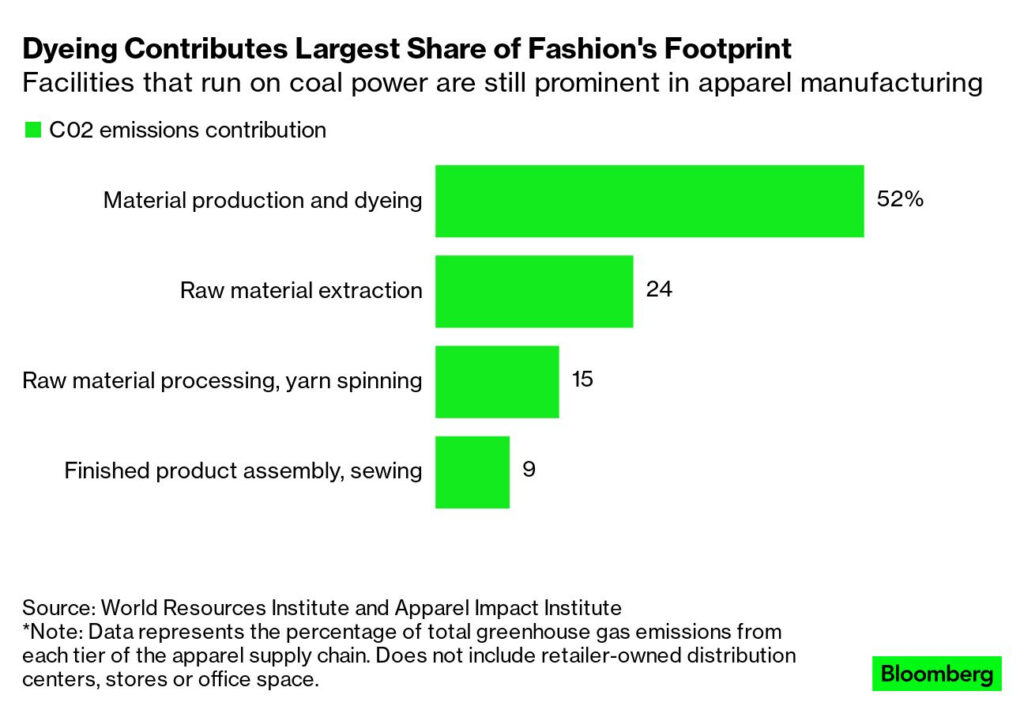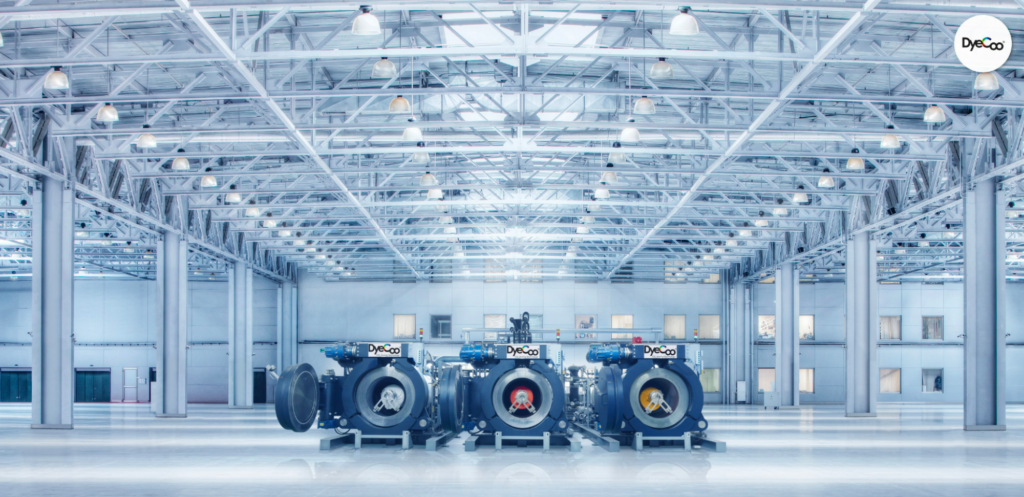Startups Racing to Solve Fashion’s Fossil-Fueled Challenge

|
Listen to this story:
|
Transferring dye to fabric is incredibly carbon-intensive. Newer sustainable techniques, including coloring with carbon dioxide, may help.
At a factory in Vietnam, workers load rolls of undyed polyester into a steel container connected to a storage tank that holds carbon dioxide. When pressure in the container is turned up, the CO2 takes on the properties of both gas and liquid, and in turn develops a superpower: the ability to dissolve dye.
The factory, which uses technology supplied by Dutch startup DyeCoo Textile Systems, is making clothes colored by carbon dioxide. DyeCoo says its process for getting colorants onto fabric doesn’t use any water or bonding chemicals — water is still needed for rinsing, though — and can halve a factory’s typical water use and emissions from textile dyeing. (About 95% of the CO2 can also be recycled between jobs.)
Since 2010, the company has been working with garment makers in Taiwan, the Netherlands and Southeast Asia, and its backers include Nike Inc.’s venture arm and Ikea. DyeCoo is one of several startups exploring new ways to dye textiles. While the fashion industry gets flak for producing cheap clothes, burning unwanted stock, relying on plastic-based materials and shipping goods around the globe, the energy-intensive dyeing process is one of its most intractable challenges.
A recent report from industry group Fashion for Good estimated that, together with fabric pre-treatment and finishing, dyeing is responsible for over half of the industry’s total emissions. As consumers and investors put pressure on apparel companies to cut back on carbon, finding a greener way to add color could be a big opportunity.

Dyeing clothes is carbon-intensive because of what it involves and where it tends to take place. Most methods call for water hot enough to loosen fabric fibers so that they’ll accept the dye, and/or hot water to scour, bleach or wash fabrics. This is all part of a textile production stage known as “wet processing,” which also includes producing patterns and finishing fabrics prior to assembly.
In the countries where most wet processing takes place — including China, Vietnam and India — coal tends to be the cheapest and most dominant source of energy. Factories rely on it, creating a vicious cycle: Cheap coal allows for cheap textile manufacturing, which creates cheap clothes, which perpetuates the need for cheap coal. According to one report from environmental consultancy Quantis, boilers running on coal and natural gas were responsible for 44% of the carbon footprint in textile dyeing in 2016, and electricity from coal-burning power plants accounted for another 17%. Startups like DyeCoo are trying to tackle dyeing’s emissions directly.
In Japan, Debs Corporation says its AirDry process, which transfers dye from paper to fabric via a printer-like machine, uses up to 95% less water and 86% less energy than traditional dyeing. British startup Alchemie Technology has a similar technique and promises equivalent reductions in energy use.

DyeCoo says its CO2-based process for getting colorants onto fabric doesn’t use any water or bonding chemicals. Courtesy of DyeCoo
Upgrading machinery alone won’t solve textile production’s environmental issues. Many garments, including DyeCoo’s polyester, are made from synthetic fibers that are themselves derived from fossil fuels. Most textiles are also colored with synthetic dyes, which are both fossil-fueled and major freshwater pollutants that harm human health.
That’s where entrepreneurs like Chui Lian Lee come in. In 2018, Lee co-founded Werewool Inc. out of New York. The startup is mimicking the DNA sequence of discosoma coral — which produces a bright pink protein — and then inserting it in microbes that can proliferate through fermentation. The resulting proteins are combined with proteins from agricultural residue to form colored fibers.
Werewool aims to manufacture its first batch of protein-based pink fibers by the end of this year. Colorado-based Living Ink Technologies is also exploring new ways to make colorants. The startup makes black powder out of biomass waste collected from companies that grow algae as a food additive. Living Ink co-founder Scott Fulbright says they have printed two million T-shirts for Nike with the algae dye, which will also be used on Coach leather goods next year. The company is now working on additional colors.

New York-based Werewool Inc. is using protein that mimics the DNA sequence of coral to form colored fibers. Photographer: Jon Brown/Werewool
Figuring out how to make more sustainable pigments and fabrics, and how to apply the former to the latter, is only the first gauntlet for greening textiles. Fashion relies on production that’s low-cost and extremely flexible, which can make adopting new technologies hard to justify — especially if they’re more expensive, functionally limited and not required by regulators.
There’s also the fragmented and impermanent nature of most fashion supply chains.Eventually, regulation could help move the needle. The European Commission is busy drafting legislation that would hold fashion companies accountable for the environmental impact of the clothes they produce. Overcoming technological, economic, logistical and regulatory challenges will be increasingly necessary if the fashion industry is to make good on its climate goals. So will cracking the science on large-scale low-carbon dyeing for all fabrics and colors.
At the moment, Living Ink’s algae-derived pigment only comes in black, and DyeCoo’s CO2 process only works on polyester. Since launching a prototype in 2010, DyeCoo managing director Kasper Nossent says the company has sold 17 machines across eight factories.
Writers: Olivia Rockeman and Coco Liu






